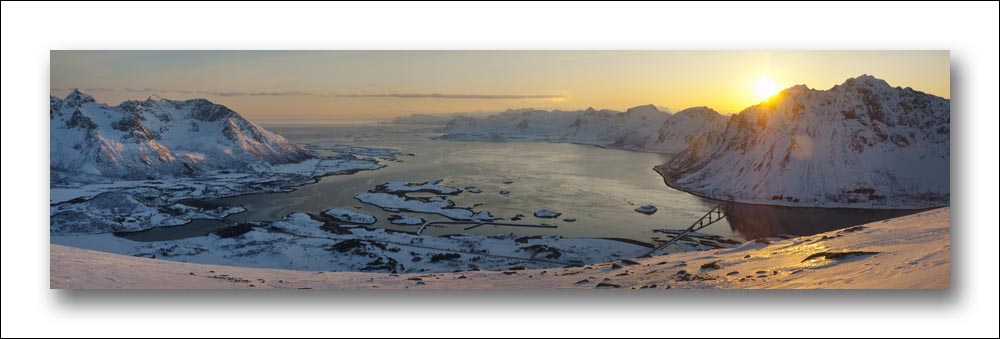Part One: First impressions
It was really a great experience, when I approached the Lofoten in March 2010.
Weather was rather bad . It was snowing since days and still didn't stop.
Between the snowshowers I could catch a glimpse of rocky mountains and small
islands all covered with fresh powder snow. ...
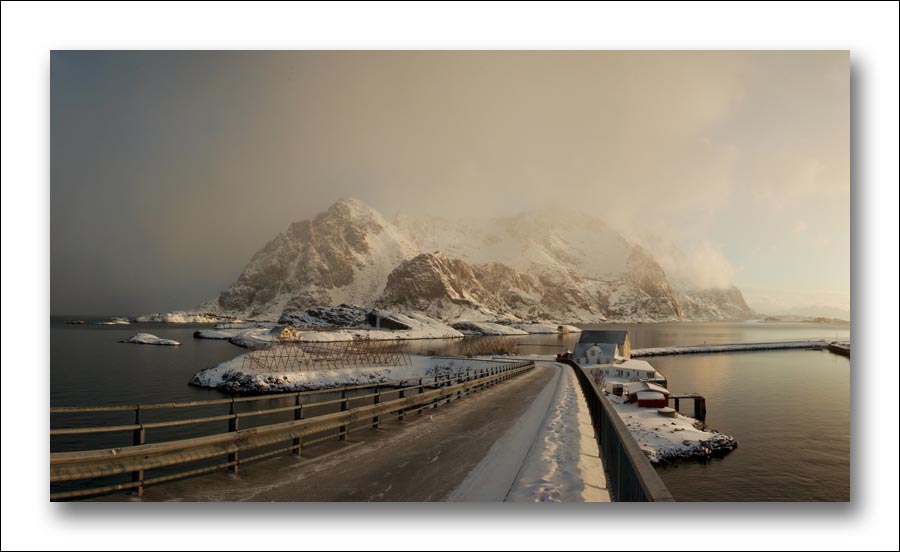
Snow shower over Festvågtinden near
Henningsvær
Panorama stitched of 6 frames in one row
(Single shot: Nikon D70, 18-70mm at 24mm, corresponding to 37 mm for
36-mm-film)
|
... That was the sight I was hoping for when I started in Münster four days
earlier.
The first campground I droped in was that on the Sildpollen-peninsula. In the
first evening I did not realize what an extraordinary place that is. ...
|
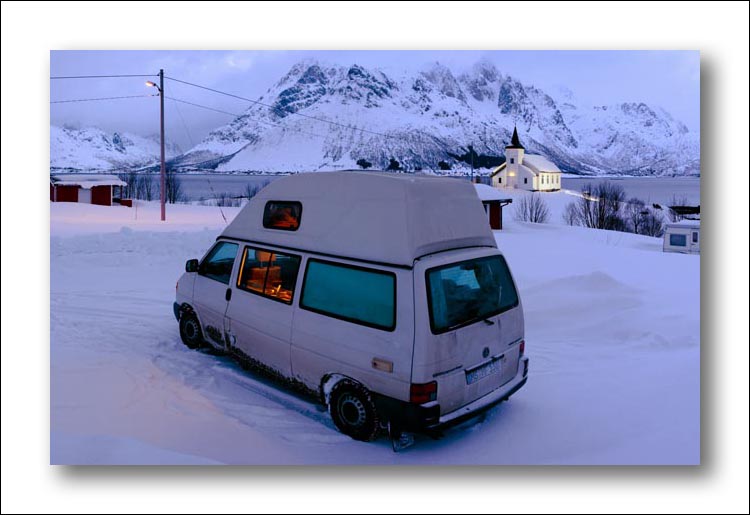
My campingcar at Sildpollen Camping
(Panorama stitched of 4 frames in a single row
Single shot: Nikon D70,
18-70mm at 24mm, corresponding to 37 mm for 36-mm-film)
|
... The snow splashed against the
windows and I was happy to be well protected against the winter weather in my
campingcar. ...
|
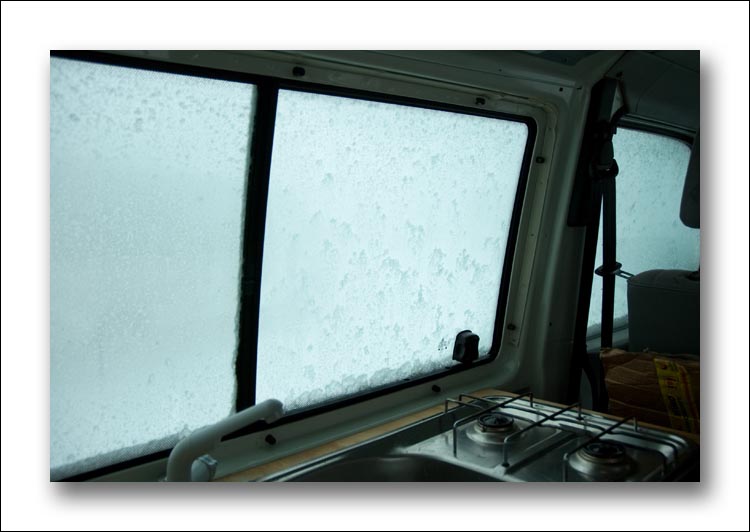
Snow shower from inside the campingcar
|
... Some days later, when I came to
this place again, the weather had changed completely. The nearby viewpoint
offered a stunning view over Austnesfjorden with the Sildpollen chapel in the
foreground.
|
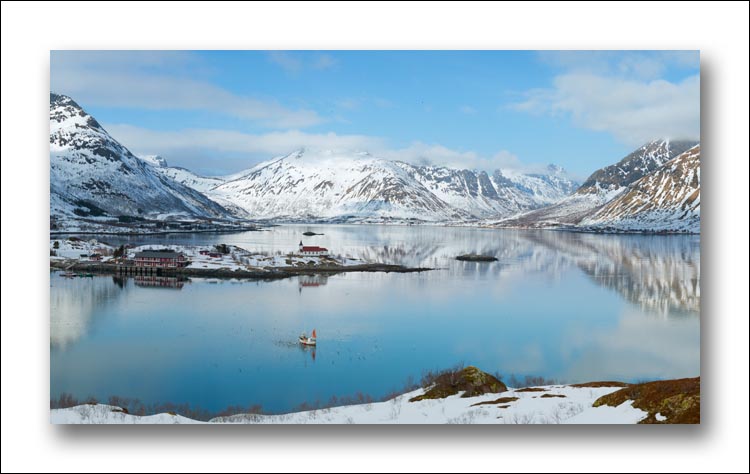
Austnesfjorden with Sildpollen chapel
Panorama stitched of 36 frames in 3 rows
(Single shot: Nikon D70, f13, 1/320sec
70-21mm at 116mm, corresponding to 174 mm for 36-mm-film)
|
|
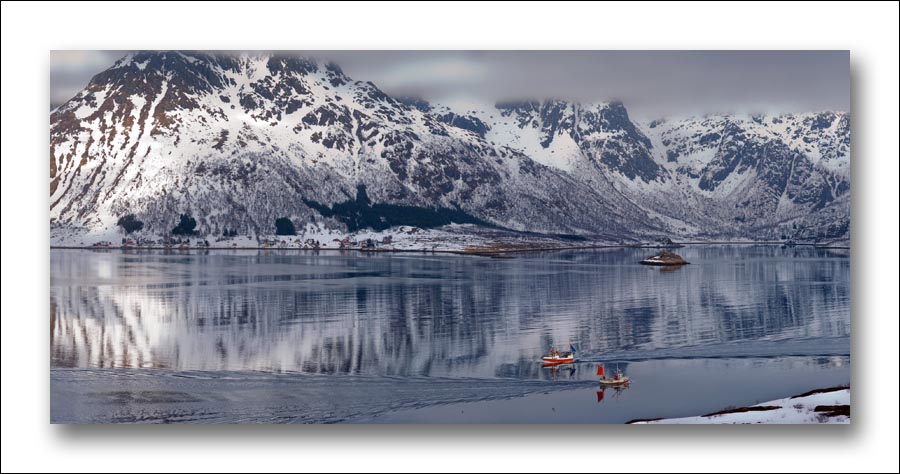
Austnesfjorden
Panorama stitched of 15 frames in 2 rows
(Single shot: Nikon D70, f13, 1/100sec
70-21mm at 116mm, corresponding to 174 mm for 36-mm-film)
|
|
Late winter is high season for
fishing, and fishing boats are everywhere in the harbours, in the fjords and the
open sea. |
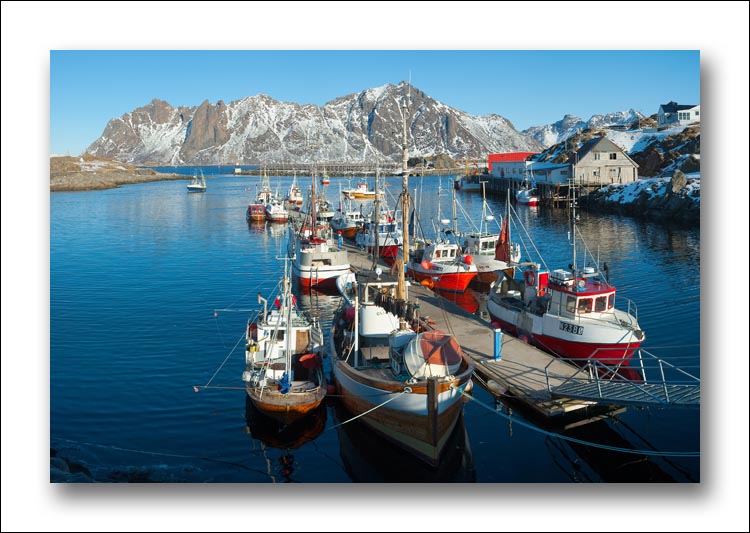
Harbor of Hovden, Langøya, Vesterålen
Panorama stitched of 36 frames in 3 rows
(Single shot: Nikon D70, f9, 1/400sec
18-70mm at 48mm, corresponding to 72 mm for 36-mm-film)
|
Much of the freshly cought fish is
hang on wooden frames to become the famous stockfish after some weeks of drying.
|
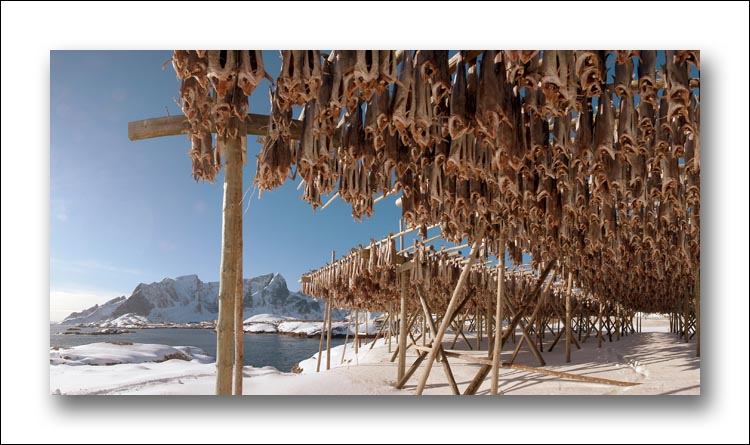
Stockfish at Hamnøy, Moskenesøya
Panorama stitched of 5 frames in 1 row
(Single shot: Nikon D70, f16, 1/200sec
18-70mm at 18mm, corresponding to 27 mm for 36-mm-film)
|
Svolvaer is the capital of the
Lofoten. Although it is a small town it has the flair of an upcomming tourist
center.
|
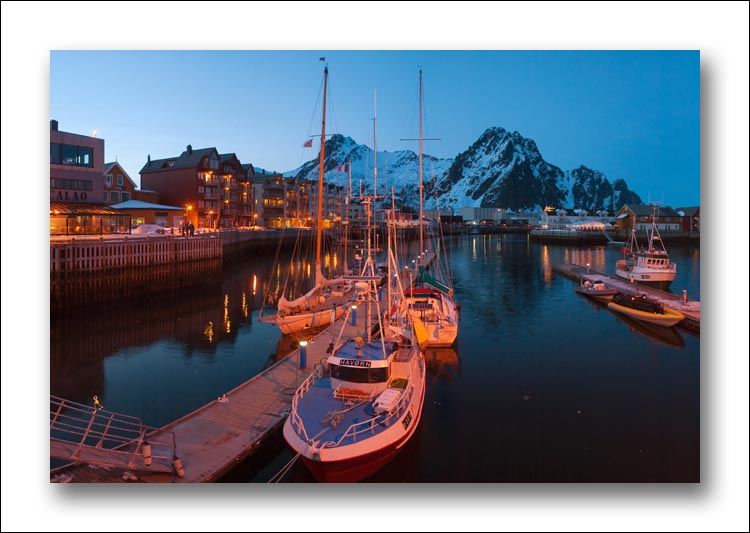
Svolvær
Panorama stitched of 3 frames in 1 row
(Single shot: Nikon D70, f5,6, 0,8sec
18-70mm at 18mm, corresponding to 27 mm for 36-mm-film)
|
|
My first visit to Svolvær was still
under snowstorm conditions. ... |
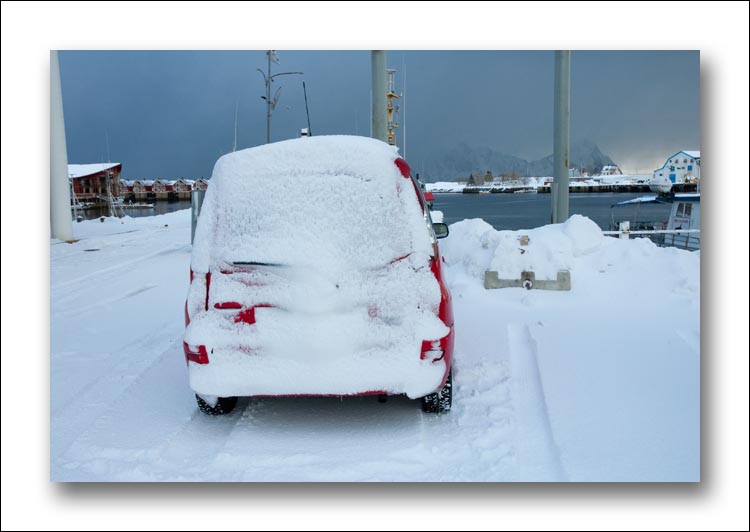
After a snowstorm in the harbour of
Svolvær
(Nikon D70,1/250sec, f 8,
18-70mm at 24mm, corresponding to 36mm for 36-mm-film)
|
|
... But a few days later the doves
took a bath in the melting ponds on the central place of Svolvær. |
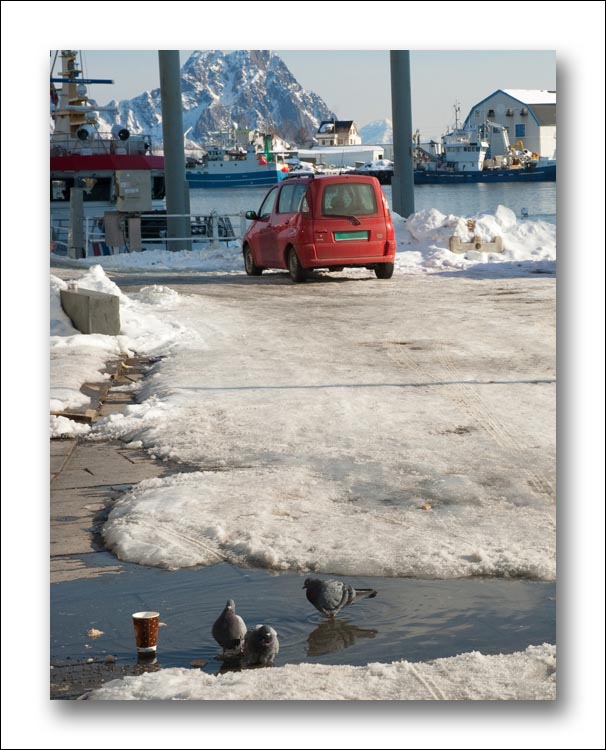
Doves in a melting pond at Svolvær
(Nikon D70,1/4000sec, f 11,
18-70mm at 46mm, corresponding to 69mm for 36-mm-film)
|
|
Driving threw a stormy snow shower
is a little advantureous. ... |
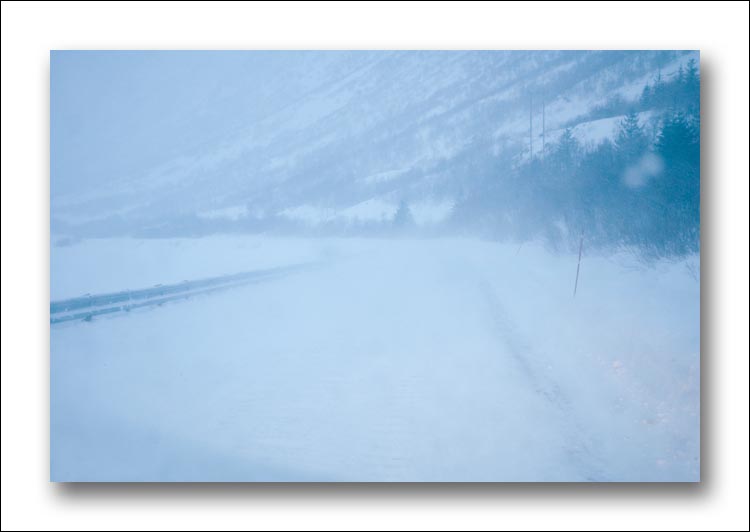
E 10 near Kabelvåg in snow shower
(Nikon D70,1/25sec, f 4,5
18-70mm at 44mm, corresponding to 66mm for 36-mm-film)
|
|
... But I had not to wait longtime
until the weather cleared and everything including the road was covered with a
marvelous coat of fresh snow. |
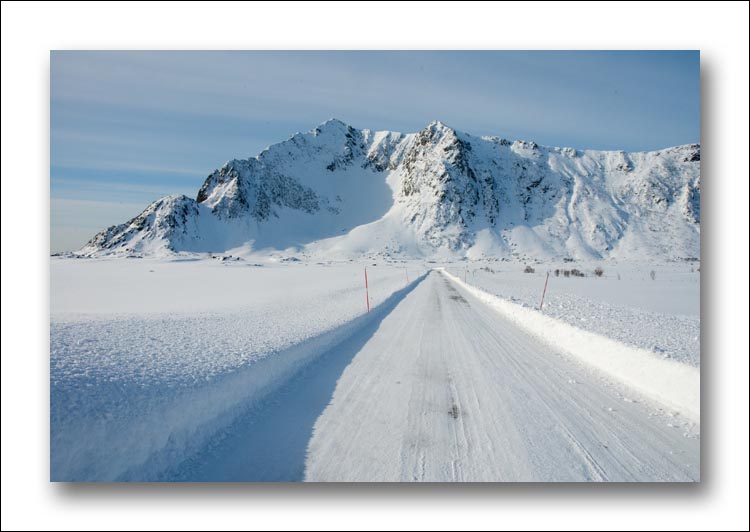
Road to Stamsund
(Nikon D70,1/250sec, f 16
18-70mm at 18mm, corresponding to 27mm for 36-mm-film)
|
|
I visited many of the small
harbours. A very nice one is Henningsvaer, which I photograhed in the short
minutes between a leaving and an upcomming snowshower. |
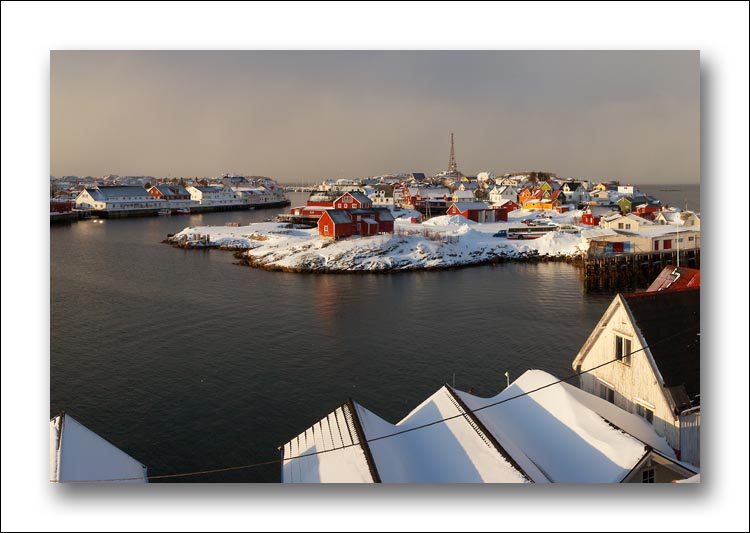
Henningsvær
Panorama stitched of 6 frames in 1 row
(Single shot: Nikon D70, f13, 1/200sec
18-70mm at 35mm, corresponding to 52 mm for 36-mm-film)
|
|
Nyksund is another place which I
like very much. It is restored from an old fishing harbour to a small cultural
town. It is located at the northwestern tip of Langøya (Vesterålen). |
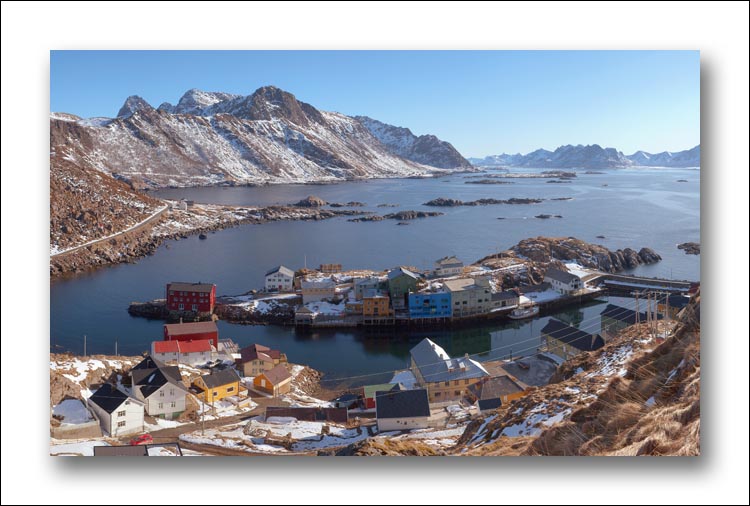
Nyksund and Prestfjorden
Panorama from 17 images in 2 rows
(Single shot: Nikon D70, f10, 1/250sec
18-70mm at 48mm, corresponding to 72 mm for 36-mm-film)
|
|
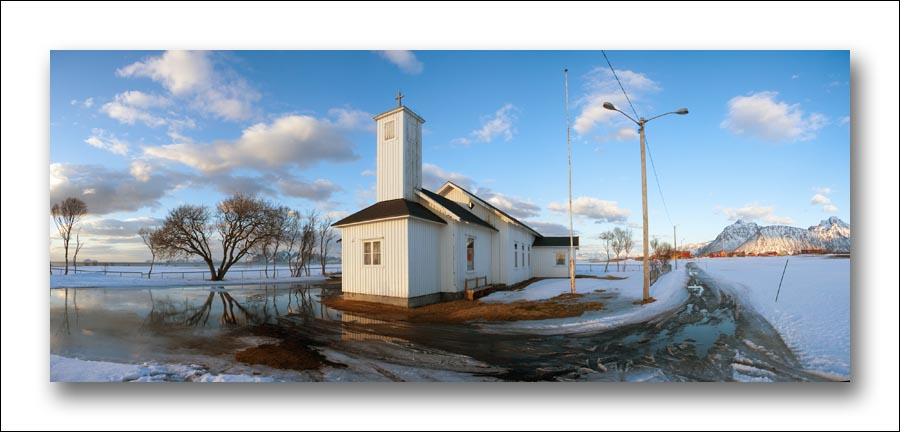
Chapel at Hadselsand
Panorama stitched of 5
frames in 1 row
(Single shot: Nikon D70, f5, 1/400sec
18-70mm at 18mm, corresponding to 27 mm for 36-mm-film)
|
Small settlements are scattered all
over the archipel.
The vivid coloured houses contrast nicely with the water and white landscape. |
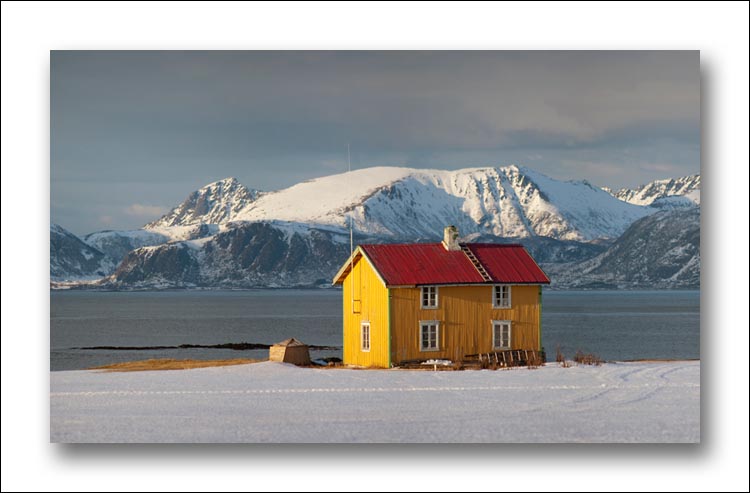
House at the shore of Hadselfjorden
Panorama stitched of 4 frames in 1 row
(Single shot: Nikon D70, f5, 1/650sec
70-210mm at 170mm, corresponding to 255 mm for 36-mm-film)
|
|
__________________________________________________________________________
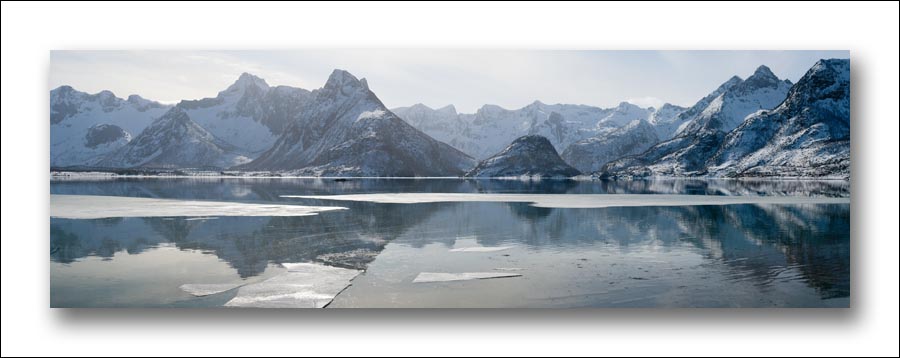
Grunnførfjorden
Panorama stitched of 22 frames in 2 rows
(Single shot: Nikon D70, f16, 1/1000sec
70-210mm at 95mm, corresponding to 142 mm for 36-mm-film)
|
The main reason why I came here was
to see and photograph the wild and natural coast in winter.
The inner parts of the fjords were covered with ice. But some warm days and the
tide let it break up. (↑)
In the clear cold nights a thin layer of ice freezes along the shoreline. As the
tide lowers the ice coats the costal rocks like a thin skin. (→) |
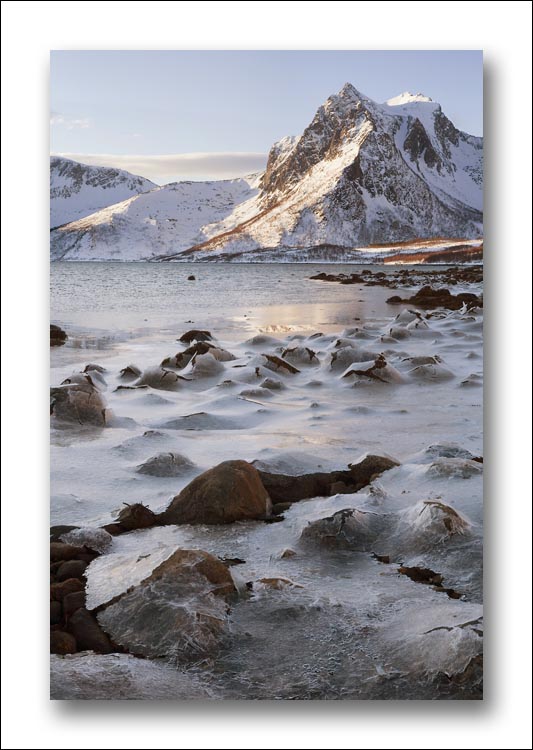
Morfjorden
Detail of a panorama stitched of 14 frames in 2
rows
(Single shot: Nikon D70, f16, 1/80sec
18-70mm at 44mm, corresponding to 66 mm for 36-mm-film)
|
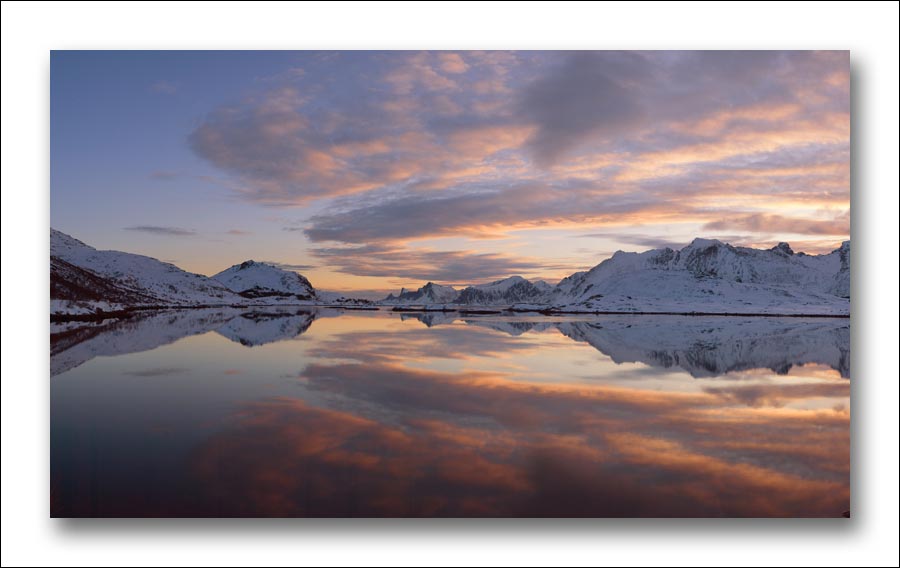
Torsfjorden , Moskenesøya
Panorama stitched of 14 frames in 2 rows
(Single shot: Nikon D70, f8, 1/30sec
18-70mm at 46mm, corresponding to 69 mm for 36-mm-film)
|
Water,
the coast line
and the ever changing light
create breathtaking views again and again. |
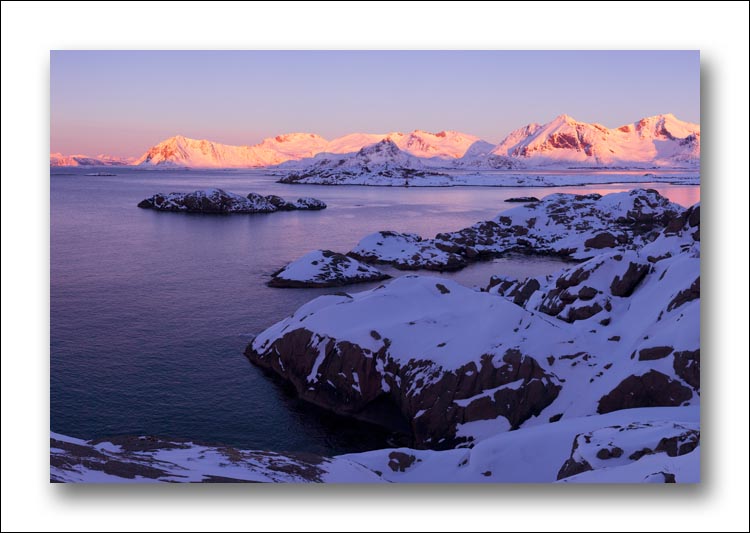
Morning light on the mountains of Vestvågøya, seen from Lyngvær
Panorama stitched of 20 frames in 2 rows
(Single shot: Nikon D70, f8, 1/160sec
55mm (Mikro-Nikkor), corresponding to 82 mm for 36-mm-film)
|
|
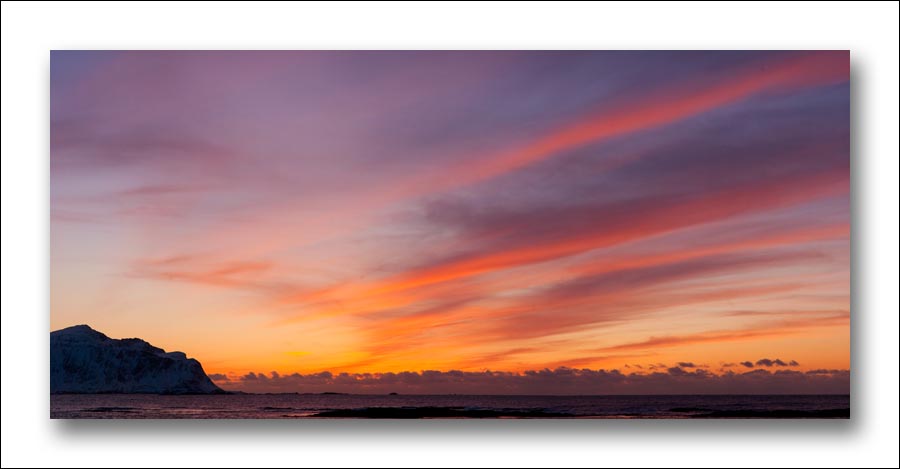
Sunset at Flakstad beach
Panorama stitched of 5 frames in 1 row
(Single shot: Nikon D70, f7, 1/125sec
18-70mm at 70mm, corresponding to 105 mm for 36-mm-film)
|
|
__________________________________________________________________________
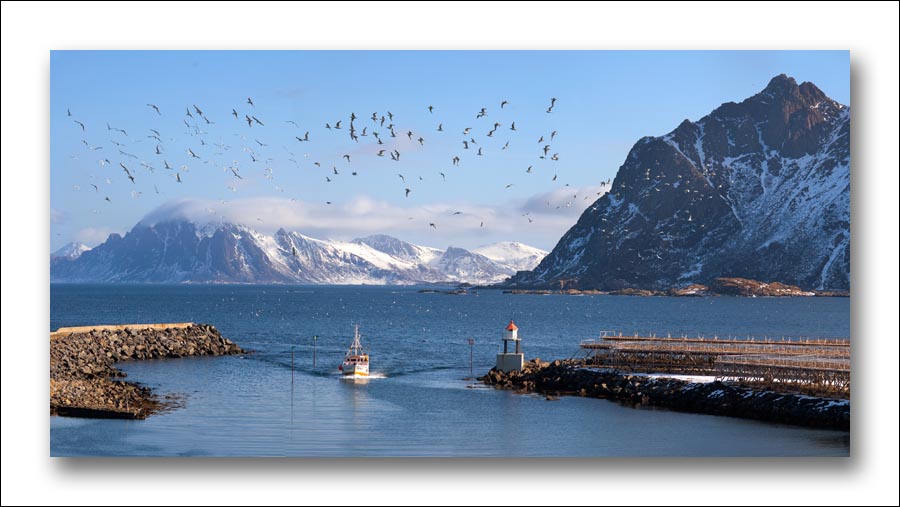
Kittiwakes above the harbour of
Hovden, Langøya, Vesterålen
Panorama stitched of 4 frames in 1 row
(Single shot: Nikon D70, f9, 1/500sec
70-210mm at 95mm, corresponding to 142 mm for 36-mm-film)
|
The landscape still looks like
winter, but the bird life points toward the upcoming spring.
The kittiwakes are going to occupy their breeding colonies, although the
temperature is obviously below zero. |
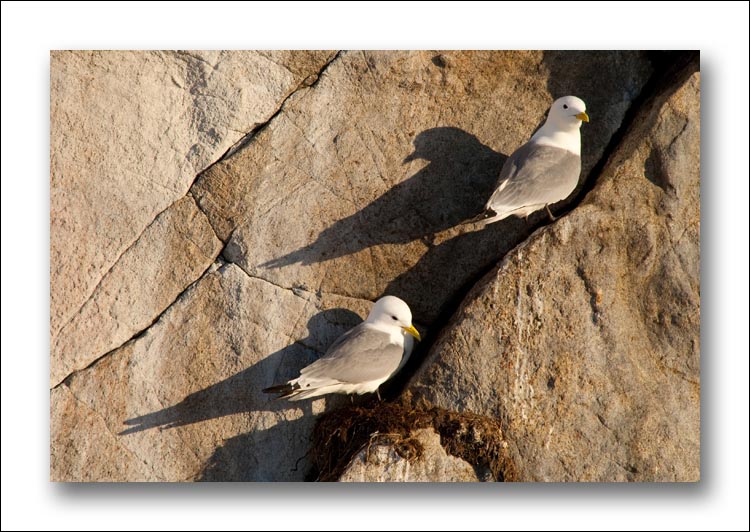
Kittiwakes in their colony at Nykvår
(Nikon D70, f11, 1/250sec
1300mm, corresponding to 450 mm for 36-mm-film)
|
|
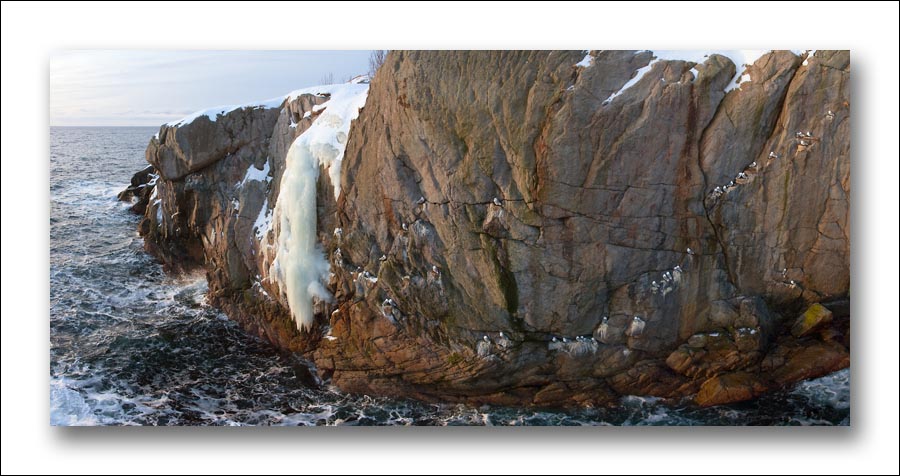
Frozen waterfall in the middle of a breeding colony of Kittiwakes, Hamnøy
Panorama stitched of 4 frames in 1 row
(Single shot: Nikon D70, f8, 1/80sec
18-70mm at 18mm, corresponding to 27 mm for 36-mm-film)
|
|
_________________________________________________________________________
Part Two: Views From
Snowshoe Hiking Tours
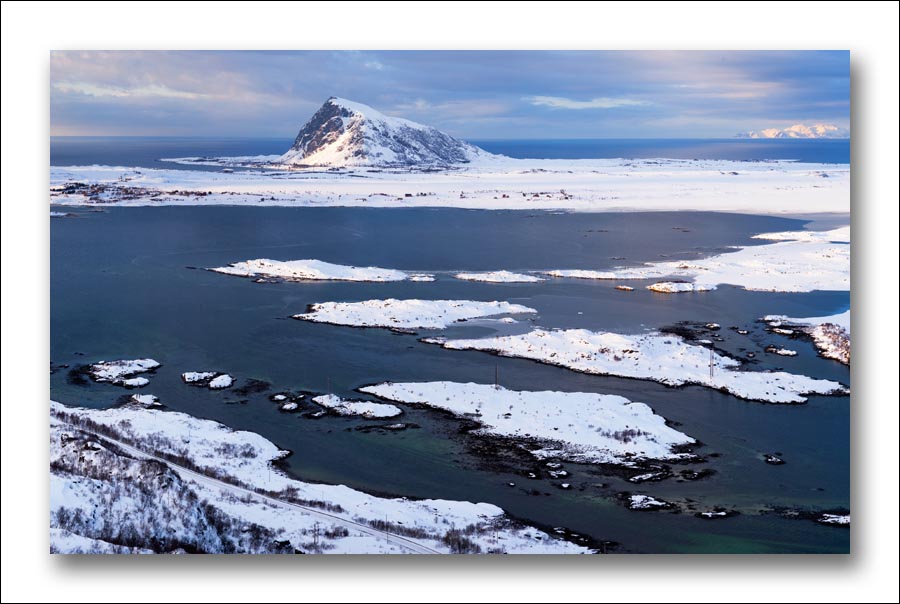
Sundklakkstraumen and the western part of
Gimsøya from south
Panorama stitched of 45 frames in 3 rows
(Single shot: Nikon D70, f7,1, 1/320sec
70-210mm at 125mm, corresponding to 187 mm for 36-mm-film)
|
The first walking tour was on a
nameless ridge just a few hundred meters northwest of Sundklakks-traumen bru.
This short trip was undertaken to test my equipment, especially the modern
snowshoes (msr-denali-classic with flotation tails) which are very helpful
particularly in steep terrain.
The short effort was rewarded with a fantastic view over Sundklakkstraumen to
the mountain Hoven in the western part of Gimsøya. (↑) |
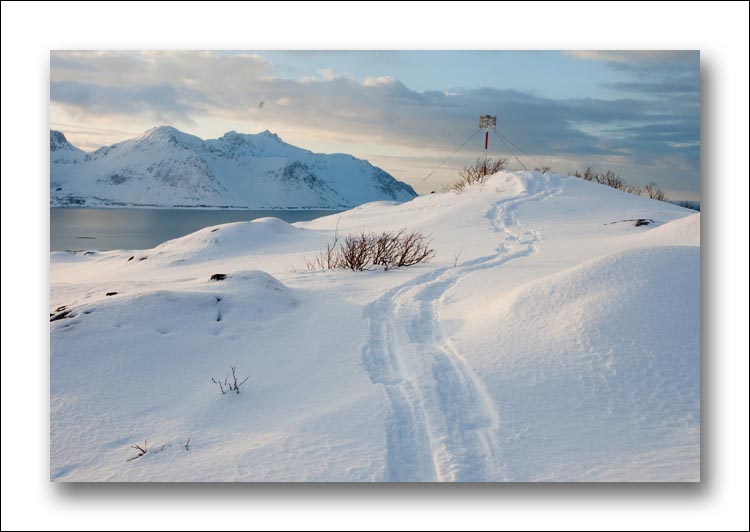
Tracks of my snowshoes
|
|
Searching for new tracks, I scanned
the mountains with my binocular and found many tracks in the snow. That was the
case with the mountain in the background of this photograph. It is called
Kleppstadheia. |
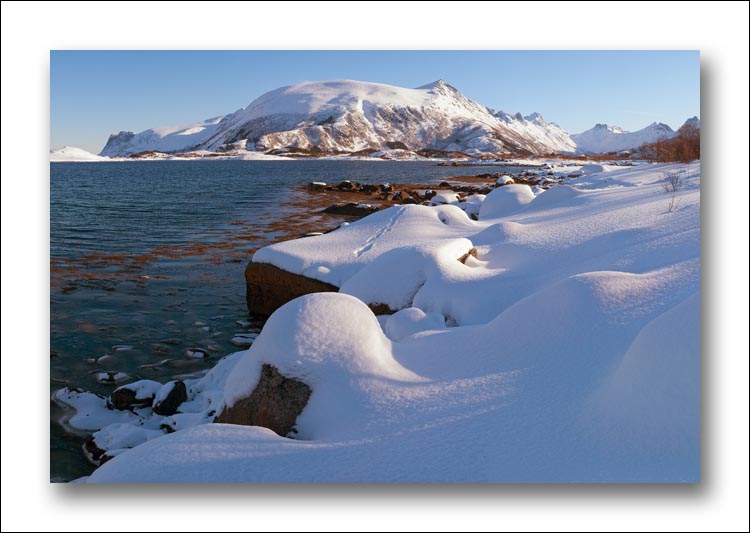
Lyngværstranda and Kleppstadheia
Panorama stitched of 27 frames in 3 rows
(Single shot: Nikon D70, f16, 1/160sec
70-210mm at 70mm, corresponding to 107 mm for 36-mm-film)
|
|
The port of Kleppstad from sea level
(→) |
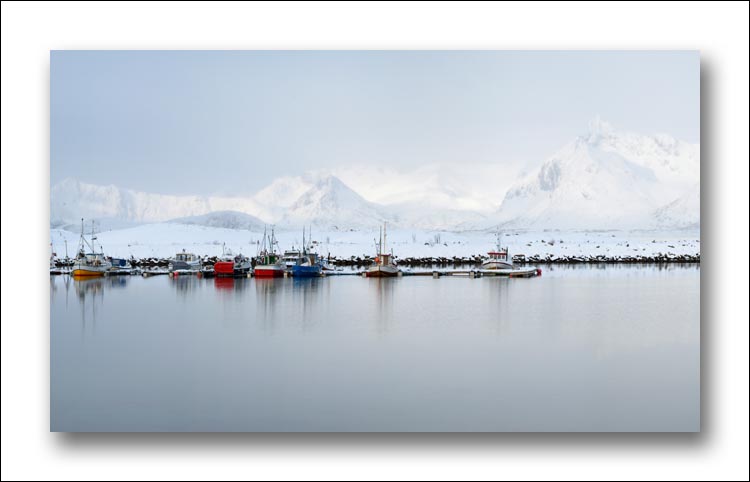
Panorama stitched of 12 frames in 2 rows
(Single shot: Nikon D70, f8, 1/640sec
70-210mm at 170mm, corresponding to 255 mm for 36-mm-film)
|
The port of Kleppstad and
Gimsøystraumen from Klepstadheia after sunset. (→)
(The first image of this site shows the same view at sunset.) |
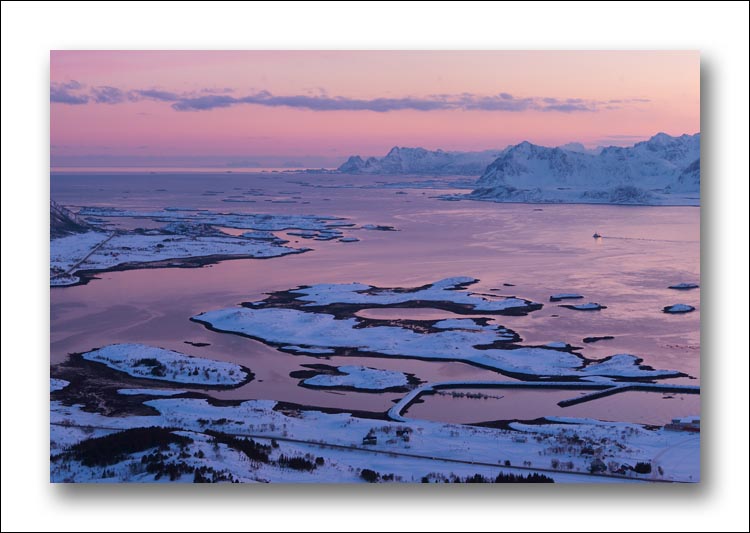
Detail of a panorama stitched of 6
frames in 1 row
(Single shot: Nikon D70, f6,3, 1/25sec
70-210mm at 70mm, corresponding to 105 mm for 36-mm-film)
|
|
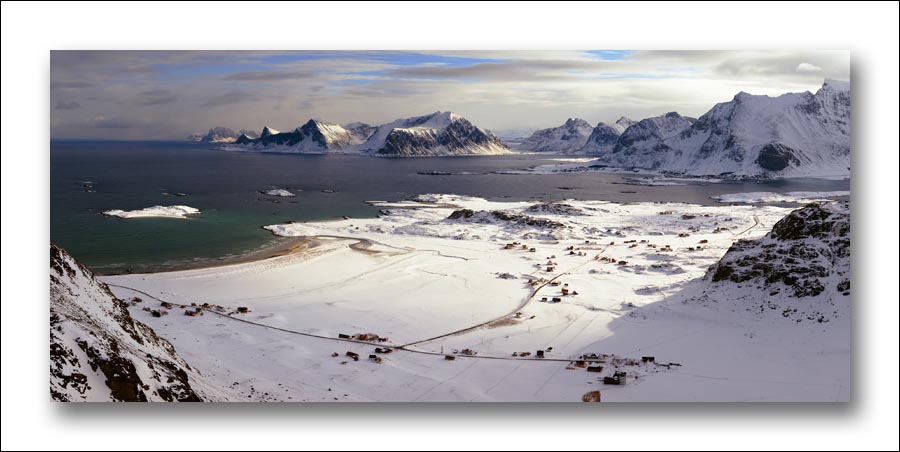
View from Ryten towards Sand and Fredvang (North of Moskenesøya)
Detail of a panorama stitched of 39
frames in 3 rows
(Single shot: Nikon D70, f10, 1/500sec
70-210mm at 102mm, corresponding to 153 mm for 36-mm-film)
|
The most beautiful mountain top I
climbed was Offersøy-kammen, which is found at the western shore of Vestvågøya.
When I scanned the landscape with binoculars from the roadside, I saw a fresh
track in the snow leading right up to the top. I followed the track and came to
a top with breathtaking view.
In the south you see the line of the E 10, the Nappstraumen and the Skottinden
near Ballstad.(↓)
|
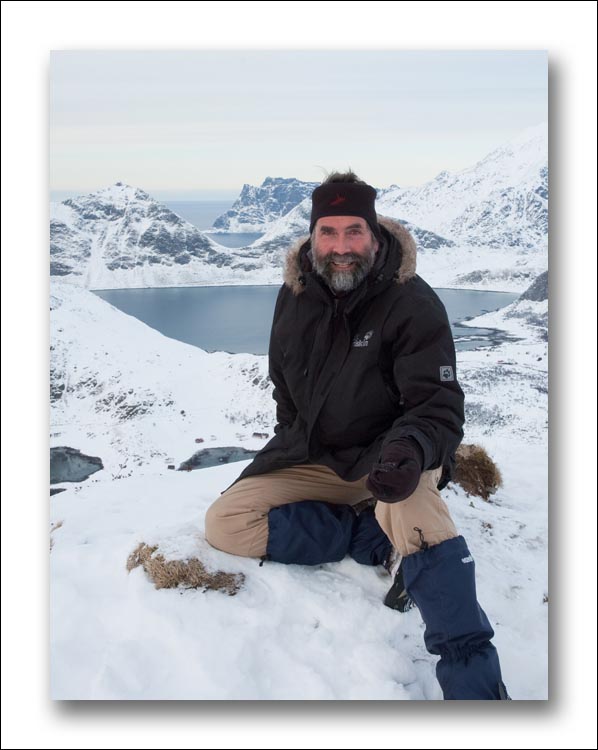
|
|
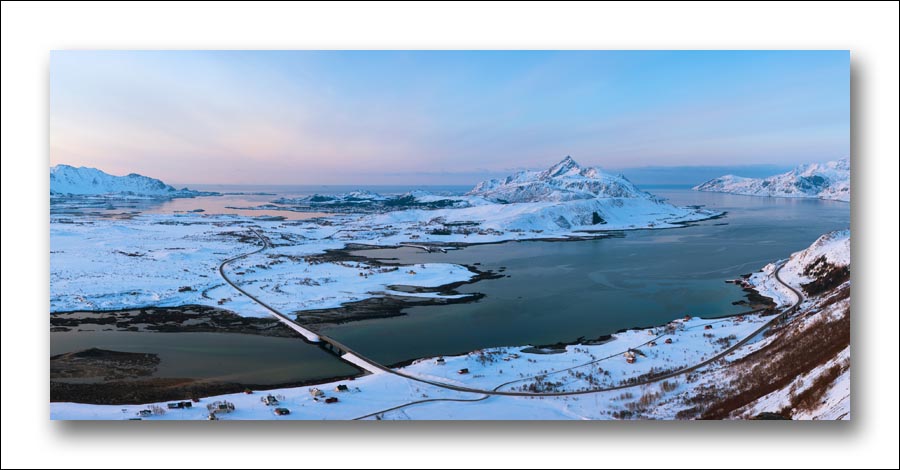
Panorama stitched of 30 frames in 3 rows
(Single shot: Nikon D70, f8, 1/60sec
18-70mm at 62mm, corresponding to 93 mm for 36-mm-film)
|
|
In the north there are bays and rocks beginning with Vågspollen, very close and
the rocks around Utakleiv in the background. (↓)
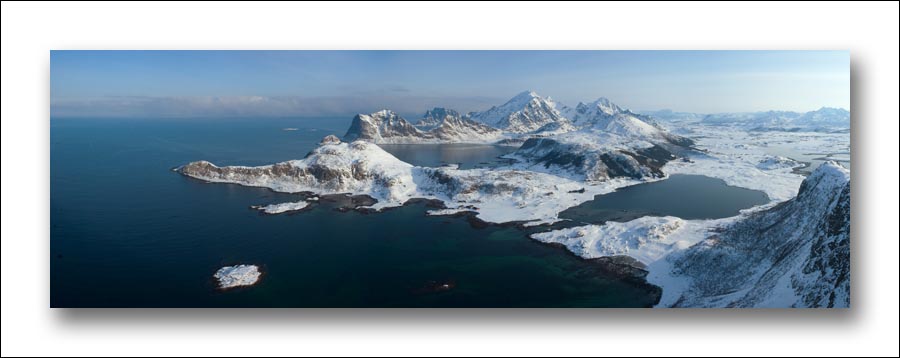
Panorama stitched of 7 frames in 1 row
(Single shot: Nikon D70, f11, 1/200sec
18-70mm at 25mm, corresponding to 37 mm for 36-mm-film)
|
|
In the west there is Stornappstinden the most eastern mountain of Moskenesøya
right in front of you. (↓)
When I was up there in the late evening, the sun was reflected by the water of
Nappstraumen. But as the sun was hidden in parts behind clouds and in parts
behind the mountain, it painted a golden strip in the water deep below, a
spectacular lightshow just for me standing alone at the top of Offersøykammen.
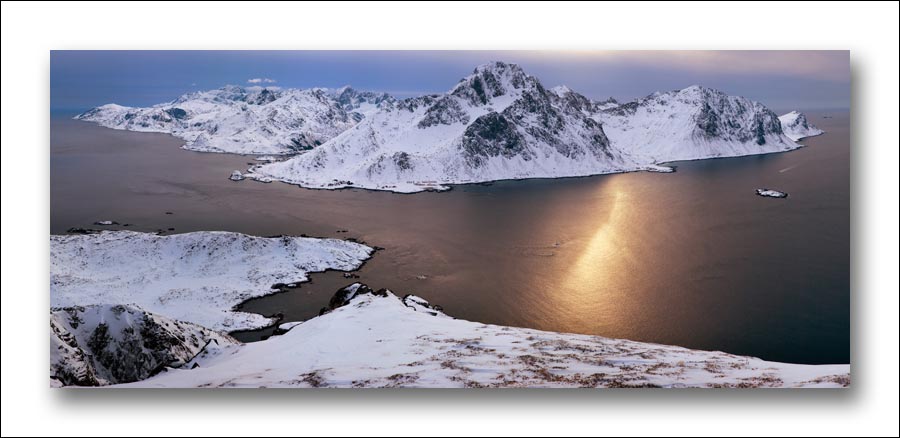
Detail of a panorama stitched of
15 frames in 2 rows
(Single shot: Nikon D70, f10, 1/200sec
18-70mm at 62mm, corresponding to 93 mm for 36-mm-film)
A considerable faciliation was the use of a digital camera with pano head
instead of the classical large formate camera. The digital equipment was
much lighter but nevertheless it provided photographes with very high
resolution. So the hiking tours turned out to be more fun than ever before!
|
